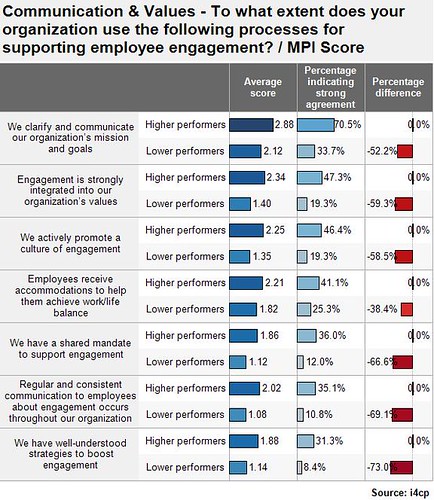How High-Performers Support Employee Engagement
Engagement! Engagement! Engagement! The word continues to ring through the halls of business, hyped as a crucial weapon against attrition and a catalyst for improved employee productivity, both of which are especially important amidst workforce reductions and a struggling economy. i4cp research has consistently shown a strong correlation between employee engagement and a variety of other factors in determining high-performance organizations.
But you probably already know that. The question is: What processes and tactics can organizations use to boost employee engagement?
In a study commissioned by the American Society for Training & Development (ASTD) late last year, we asked companies to tell us which processes were used to support employee engagement.
Employee engagement processes: The standard view
The chart below shows the basic results from the i4cp/ASTD study, with more than half of companies saying they clarify and communicate their mission and goals to employees to support engagement. Engagement integration into organizational values was second highest, as indicated by 33% of organizations.

Employee engagement processes: The interactive view
The chart above makes it pretty clear that there is lots of room for improvement in organizations looking to boost employee engagement, but it doesn't show the full picture. Using i4cp's new Interactive Data functionality, i4cp staff and members alike are able to dive into the data, strip out middle-tiered companies - based on market performance index (MPI) ratings - and focus on how high-performing company responses vary from the low-performing ones. Doing so reveals some major gaps between the two, as seen here:

This Interactive Data view shows that, in fact, 71% of high-performing organizations are communicating their mission and goals to employees, whereas only 34% of low-performing organizations are doing so. There are even wider gaps when looking at many of the other engagement options; for instance, a scant 8% of low-performing organizations have a well-formed engagement strategy compared to 31% of high-performers.
Conclusion
If you're at a company that's increasingly relying on the engagement of its workers to boost productivity and develop a competitive advantage, the gaps in strategy shown above can serve as opportunities to make strong headway with your employees. And while improving employee engagement is not necessarily easy, many of the processes identified here rely on communication and clarity - things that don't cost a lot of money, time or resources.
Employee Engagement Resources
But you probably already know that. The question is: What processes and tactics can organizations use to boost employee engagement?
In a study commissioned by the American Society for Training & Development (ASTD) late last year, we asked companies to tell us which processes were used to support employee engagement.
Employee engagement processes: The standard view
The chart below shows the basic results from the i4cp/ASTD study, with more than half of companies saying they clarify and communicate their mission and goals to employees to support engagement. Engagement integration into organizational values was second highest, as indicated by 33% of organizations.

Employee engagement processes: The interactive view
The chart above makes it pretty clear that there is lots of room for improvement in organizations looking to boost employee engagement, but it doesn't show the full picture. Using i4cp's new Interactive Data functionality, i4cp staff and members alike are able to dive into the data, strip out middle-tiered companies - based on market performance index (MPI) ratings - and focus on how high-performing company responses vary from the low-performing ones. Doing so reveals some major gaps between the two, as seen here:

This Interactive Data view shows that, in fact, 71% of high-performing organizations are communicating their mission and goals to employees, whereas only 34% of low-performing organizations are doing so. There are even wider gaps when looking at many of the other engagement options; for instance, a scant 8% of low-performing organizations have a well-formed engagement strategy compared to 31% of high-performers.
Conclusion
If you're at a company that's increasingly relying on the engagement of its workers to boost productivity and develop a competitive advantage, the gaps in strategy shown above can serve as opportunities to make strong headway with your employees. And while improving employee engagement is not necessarily easy, many of the processes identified here rely on communication and clarity - things that don't cost a lot of money, time or resources.
Employee Engagement Resources
- Buy i4cp's new, limited-time Employee Engagement Toolkit, which includes a Highlight Report, survey results, Interactive Data, a Playbook and a benchmarking tool - for only $995
- Buy the ASTD report Learning's Role in Employee Engagement - $995 (free for ASTD members)
- Download a sample version of i4cp's Engagement Interactive Data

Erik is the head of marketing at i4cp, and has nearly 20 years in the market research and human capital research industry.